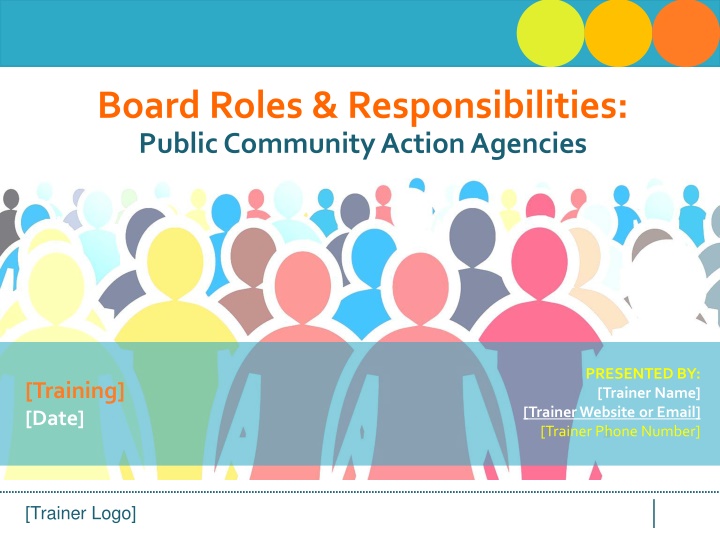
Roles and Responsibilities in Public Community Action Agencies
Explore the legal requirements and governance structures for public community action agencies, including tripartite boards, state/local government laws, and bylaws. Learn how these elements shape the authority and operation of boards in serving their communities effectively.
Download Presentation

Please find below an Image/Link to download the presentation.
The content on the website is provided AS IS for your information and personal use only. It may not be sold, licensed, or shared on other websites without obtaining consent from the author. If you encounter any issues during the download, it is possible that the publisher has removed the file from their server.
You are allowed to download the files provided on this website for personal or commercial use, subject to the condition that they are used lawfully. All files are the property of their respective owners.
The content on the website is provided AS IS for your information and personal use only. It may not be sold, licensed, or shared on other websites without obtaining consent from the author.
E N D
Presentation Transcript
Board Roles & Responsibilities: Public Community Action Agencies PRESENTED BY: [Trainer Name] [Training] [Date] [Trainer Website or Email] [Trainer Phone Number] [Trainer Logo]
This training material was created in collaboration with Community Action Program Legal Services, Inc. (CAPLAW) and the Community Action Partnership (Partnership). The publication was created by National Association of Community Action Agencies - Community Action Partnership in the performance of the U.S. Department of Human Services, Administration for Children and Families, Office of Community Services Grant Number 90ET0465. Any opinion, findings, and conclusions, or recommendations expressed in this material are those of the authors and do not necessarily reflect the views of the U.S. Department of Health and Human Services, Administration for Children and Families. 2
Legal Requirements Governing Tripartite Boards 3
Legal Requirements State/local government laws Other Bylaws/ governing document federal/state funding requirements CAA Boards CSBG grant agreement/ contract with state Federal CSBG Act, block grant regulation, guidance State CSBG statute, regulations, policies 4
State/Local Government Laws The authority of a tripartite board to take action on behalf of a public CAA is established by the federal CSBG Act. True or False Authority of a public CAA tripartite board is often established by: Local governing officials of local gov t where public CAA is a dept/division Local state/laws under which public CAA created 5
Bylaws While not always required, bylaws or a similar governing document serve as a useful operational guide for public CAA tripartite boards. True or False Bylaws establish the ways the tripartite board will operate and may describe its authority to act Bylaws typically reflect funding source requirements Ex., CSBG tripartite board composition and responsibilities; Head Start board composition, responsibilities and conflicts of interest requirements 6
Federal CSBG Act A public CAA may choose whether to use the tripartite structure as set forth in the federal CSBG Act for its board. True or False Remainder individual or group from private sector 1/3 elected or appointed public officials At least 1/3 low-income reps Requires tripartite board to actively participate in the development, planning, implementation and evaluation. 42 U.S.C. 9910(b) 7
Tripartite Composition Resources www.caplaw.org 8
HHS Block Grant Regulations HHS block grant regulations establish that the federal government will generally defer to a state s interpretation of the federal CSBG Act. True or False Apply to all block grants issued by the U.S. Department of Health and Human Services (HHS) 45 C.F.R. Part 96 Subpart I specifically applies to CSBG funding 9
OCS Guidance Guidance issued by the federal Office of Community Services (OCS) in the form of Information Memoranda (IMs) are generally legally binding on CAAs. True or False OCS IM #82 provides guidance to tripartite boards regarding: Composition requirements Role and responsibilities 10
State CSBG Act and Regulations CAAs must maintain compliance with state CSBG statutes and regulations, if they exist. True or False May contain board requirements Example, terms and/or term limits CSBG Organizational Standards 50 Standards for public CAAs from OCS IM #138 Address board composition and responsibilities Application tailored to a public CAA to account for its unique structure 11
CSBG Organizational Standards Resources www.communityactionpartnership.com and www.caplaw.org 12
CSBG Grant Agreement/Contract CSBG grant agreements/contracts are usually non-negotiable. True or False Contract/agreement should include citations or references to the state and federal CSBG requirements that apply to the board Example, tripartite composition requirement as set forth in the federal and, if exists, state CSBG laws 13
